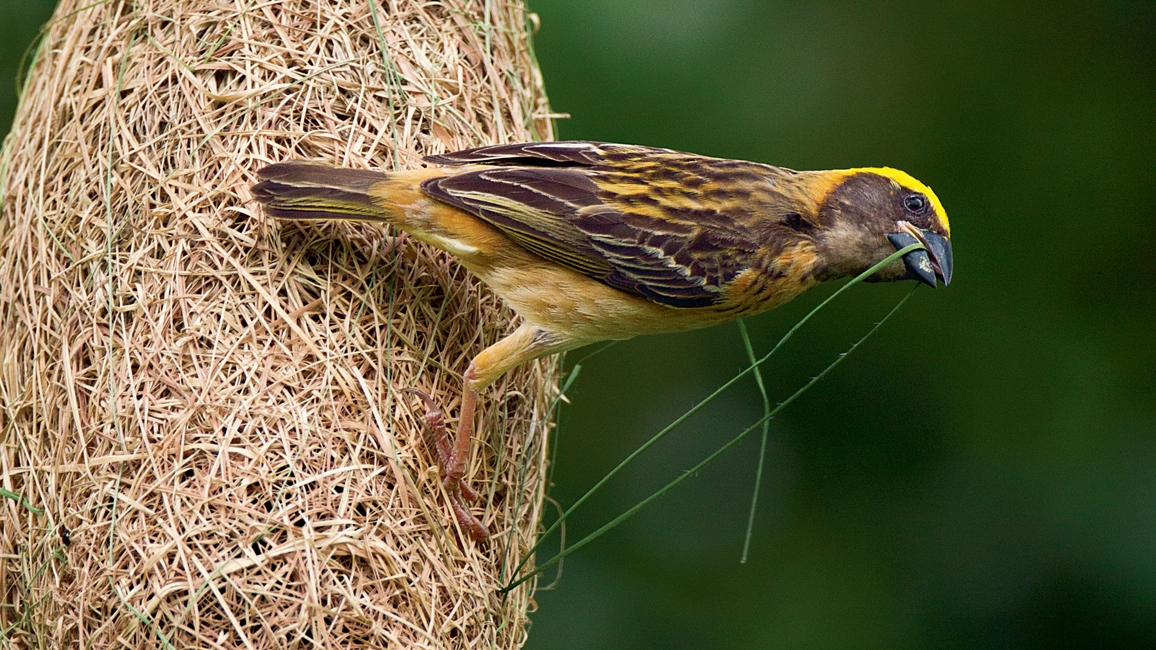
Master Builders
By Hannah Schardt; photos by Ingo Arndt/Minden PicturesThey don’t use blueprints or fancy tools. But with leaves, grass, spit, and other natural stuff, these animals create masterpieces!
One look at the baya weaver’s neatly woven nest at left tells you this bird has serious construction skills. A male weaver spends as long as two weeks weaving grass and strips of leaves into a comfy hangout. If the nest impresses a female—and who wouldn’t be impressed?—she will pair up with the male and start a family there. Read on to discover more amazing animal architects!
LEAFY ROLLUP
These weaver ants are on a roll! Several ants pull on a leaf’s edge with all their might. Then another one steps up to glue the leaf to itself with a dot of sticky spit. Soon, the ants will have a neatly rolled leaf nest—a perfect nursery for raising baby ants.
GRASS HOUSE
This mama harvest mouse wove her tennis ball-shaped nest out of grass. And she attached it to a sturdy plant stem high off the ground. When her babies are born, they’ll be safe and sound, out of reach of prowling predators.
TREETOP PENTHOUSE
A big bird needs a big nest. And the nest of a bald eagle is one of the biggest in the world. An eagle mom and dad return to the same spot year after year. They add more sticks, plant parts, and feathers to the nest for each new batch of eaglets. In a few years, this nest could be as tall as a house and as heavy as a small car!
MIGHTY MUD MOUND
Termites are tiny, ant-like creatures—usually less than an inch long. But, working together, they build the insect world’s version of a skyscraper! Each worker termite brings a tiny bit of soil or animal poop to the building site and mixes it with spit. With thousands of termites pitching in, that adds up to a mountain of rock-hard dried mud as tall as a two-story house! Inside are tunnels connecting dozens of rooms for raising young and storing food.
FANCY FIXER UPPER
The carrier shell sea snail makes strong, glue-like stuff that it uses to attach small objects to its shell. But the pebbles and shells stuck to this shell aren’t just for decoration. They help the baseball-sized snail blend in with the sea floor—and make it less appealing as a meal for predators.
STICKY ABODE
When an orb spider finds just the right spot for a web, it quickly builds a frame of silk. Then it weaves a silk spiral inside the frame. The finished web has tiny globs of glue on it. A passing fly just might get caught—and accidentally invite itself in for dinner!
DOWNY BED
This nest may not look so special at first. But take a closer peek. See the fluffy stuff around the eggs? That is eiderdown: super-soft, super-warm feathers that the mama eider (EYE-dur)—a type of duck—pulled from her chest. People sometimes use eiderdown to stuff bed coverings. But here it’s used to keep eider eggs and hatchlings warm on the chilly Iceland coast.
WATERFRONT LODGE
If you had to build a home and a wall to protect it, you’d be “busy as a beaver,” too! Beavers build dams to stop a stream’s flow and create ponds. In those ponds, they build lodges where they raise their young and store food for the winter. All that building takes a lot of wood. And since beavers don’t have chain saws, they have to rely on their big, strong teeth to take down trees. Busy, busy!
WATCH IT!
See how beavers use their teeth and paws to build their homes—and change the landscape!
PAPER PALACE
This striped “rock” is actually a wasp nest—made of paper! To make the nest, each paper wasp scrapes off a bit of wood or plant stem, chews it up, and mixes it with spit. This makes pulp—the same stuff used to make the paper you are holding now. The wasps use their jaws to form the pulp into the right shape. Each stripe on the nest is from a different plant used to make the paper.
BACHELOR PAD
These hut-like buildings aren’t nests. They’re a way for male bowerbirds to show off for females. When a male is ready to mate, he searches high and low for “bling” to decorate his stick structure: beautiful, colorful objects such as shells, flowers, or fruits. He puts them in neat piles around the hut. And if the bower does its job, it will catch the eye of a female bowerbird—or a few. Even if the building is plain, the decorating puts it over the top!
“Master Builders” originally appeared in the February 2015 issue of Ranger Rick magazine.
(Click on each image above for a closer view of the story.)




















